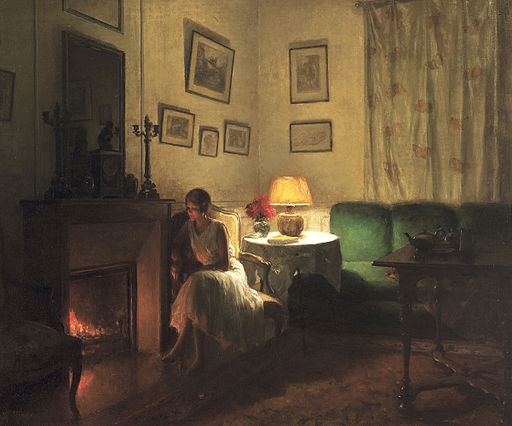
Femme à la fenêtre attendant l'arrivée d'une personne
Born in Northeastern France on March 19, 1862, Marcel Rieder was a French painter whose use of light is captivating and warm. Rieder was a sort of modern tenebrist reminiscent of Matthias Stom, Gerard van Honthorst, Joseph Wright of Derby and Georges de La Tour. His style seems to be somewhat Hopperesque. What makes Rieder unique is that all of his figures are women, predominantly, and his type of genre painting has a mysterious quality in that the figures are pensive, lost in their own world. This type of psychology is an interesting element that draws us toward his subjects and makes us reflect on our own thoughts.
In the above painting a woman stands by the window with a soft light coming through the window, waiting for someone. The composition is not terribly inventive (although the use of perspective draws us in), and the surrounding elements seem rather dull, but it is the way Rieder painted this woman that is captivating. One hand opens the drapes while the other rests on the chair to suggest the arrival of her significant other. The expression on her face is real. And the way the curtains mimic the fabric of her dress is brilliant. Reider uses a verdant view through the window that is soothing to the eye and counterbalances the warmth of the interior. I like how Reider combines the palette of both interior and exterior for the mottled fabric of the chair itself. The crooked frame on the wall behind her has an obscure reference to something but does not unsettle us.

Jeune femme songeuse, assise devant la cheminée, 1932
I absolutely love this painting. Incredible use of light, contrasting both artificial and natural "primal" light. Look at those deep shadows on the wall behind the frames. The mirror above the fireplace dimly suggests a background of more frames. What makes this painting interesting also is Reider's use of texture and color, with the long green sofa and a small bouquet of flowers on the table. Again, her dress also plays a role here, with the front reflecting the warmth of the fire, and the back reflecting the sharp light of the lamp. Once again, Rieder combines this palette into the area rug on the floor this time. The smooth yet hazy neutral tones on the wall beside the crumpled curtains...Rieder makes us feel like we are in the room with her. She is lost in thought and a trace of a smile is on her lips. How Reider was able to take ordinary objects like candle holders on the mantel and imbue them with such character against that dramatic light is a testament to his talent. This is a meditative painting, and its simplicity is pure genius.

The new toy, 1910
Here Reider verges on the sentimental, yet his ingenius complementary color palette and drama is inspiring. The chandelier seems to point like an arrow toward the main three figures, arranged in a triangular level space. Rieder uses three distinct age groups to represent innocence, affection and wistfulness, with the eldest woman, presumably the mother, looking at the child with an expression of yearning for the simplicity of childhood. Those deep shadows on the wall, with those rays of lamplight piercing into that orange wall is absolutely incredible. Rieder learned and grew beyond the tenebrist Caravaggio painters of the past into a modern interior style that is beautiful and intoxicating, without the need for violent drama or stark figures against a black space. Grace and beauty remain and yet it is still dramatic. Rieder clearly was more observant than most, and his palette can be studied endlessly.

Beauté crépusculaire au bord du lac d'Annecy
In one of his letters he wrote: "A picture of a waterfall is well done when you hear the water running." Here Rieder proves he can paint more than just interiors, and the mood he creates here is breathtaking and peaceful all at once. Look at the background palette of greens and purples, and how this contrasts with the deep warmth of the candles on the table and the way those trees frame the top of the composition. Although it is not clear what the two figures here are doing or waiting for, as the table is only set for two people, the mood itself is so serene and beautiful it doesn't really matter.
I can't think of a more astute observer of light in any modern painter than Reider, and although his subjects seem to lack clear intention it is this mystery that compels us to observe his work even more. This is a profoundly inspiring painter who is clearly not mentioned enough in perhaps what appears as sentimental to others, Rieder knew that mindfulness is the key to great painting.
Comments
Post a Comment